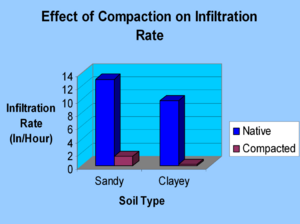
Turf
Using Compost as a Soil Amendment (Post-Construction Soil BMP)
Compost is the product resulting from the controlled biological decomposition of organic materials that has been sanitized through the generation of heat and stabilized to the point that it is beneficial to plant growth. It is an organic matter resource that has the unique ability to improve the chemical, physical, and biological characteristics of soil.
Key Considerations
Healthy, undisturbed soils provide important stormwater management functions including efficient water infiltration and storage, adsorption of excess nutrients, filtration of sediments, biological decomposition of pollutants, and moderation of peak stream flows and temperatures. In addition, healthy soils support vigorous plant growth that intercepts rainfall, returning much of it to the sky through evaporation and transpiration. Common development practices include removal of topsoil during grading and clearing, compaction of remaining soil, and planting into unimproved soil or shallow depths of poor quality imported topsoil. These conditions typically produce unhealthy plants that require excessive water, fertilizers and pesticides, further contaminating runoff.
To maintain the natural soil qualities, impacts to undisturbed soils should be avoided and minimized during the construction process. When impacts are unavoidable and soils have been compacted or otherwise disturbed, compost can be used as an amendment to regain some of the characteristics of undisturbed soils.
Figure 1 shows the effect that compaction of soils has on infiltration of water into sandy and clay soils. Uncompacted sandy soils will infiltrate up to 12 inches of water per hour. When compacted, the infiltration rate decreases to 1 inch or less per hour or a 90% reduction in the infiltration of water. Uncompacted clay soils are able to infiltrate up to 9 in per hour. However, when compacted, the infiltration rate drops to less than a ½ inch per hour or a 95% reduction in the infiltration of water. This illustrates how compacted soils contribute a significantly greater volume of runoff to the storm water system. Later discussion shows how compost can help to off-set the effect of compaction.
Establishing soil quality and depth regains greater stormwater function in the post development landscape, provides increased treatment of pollutants and sediments that result from development and habitation, and minimizes the need for some landscaping chemicals, thus reducing pollution through prevention. Establishing a minimum soil quality and depth is not the same as preservation of naturally occurring soil and vegetation. However, establishing a minimum soil quality and depth will provide improved onsite management of stormwater flow and water quality.
Benefits:
Compost can be used as a soil amendment to:
- Increase infiltration
- Reduce runoff
- Improve soil porosity
- Increase soil moisture holding capacity (reduce water demand of lawns and landscaping)
- Reduce erosion
- Absorb certain pollutants (increase cation exchange capacity)
- Reduce fertilizer needs
Comparison of Soil Infiltration after Compaction (from John Barten, Three Rivers Park District)
